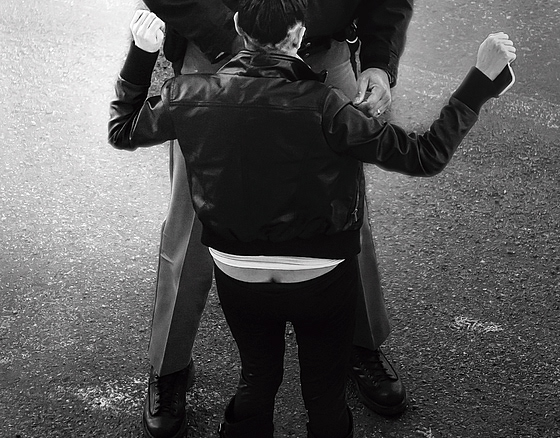The image titled "Police Line Do Not Cross" by Bob Orsillo is a striking black-and-white photograph that captures a moment of tension and intrigue. The photograph prominently features a section of police tape, which bears the bold, capitalized text "POLICE LINE DO NOT CROSS." This tape stretches diagonally across the frame, creating a visual barrier that immediately draws the viewer's attention. The background is blurred, creating a bokeh effect with indistinct light sources, which further emphasizes the sharp focus on the tape itself. The monochromatic color scheme adds a dramatic and somber tone to the image, highlighting the seriousness and gravity often associated with crime scenes or areas under investigation.
### Composition and Visual Elements
The composition of the photograph is meticulously crafted to convey a sense of urgency and restriction. The diagonal placement of the police tape creates a dynamic line that guides the viewer's eye across the image. This line not only serves as a visual barrier but also symbolizes the boundary between safety and danger, the known and the unknown. The blurred background, with its soft, out-of-focus lights, contrasts sharply with the crisp, clear text on the tape, reinforcing the idea of a clear demarcation between two distinct spaces.
The use of black and white in the photograph enhances its emotional impact. By stripping away color, Orsillo focuses the viewer's attention on the essential elements of the scene—the police tape and the blurred background. This choice of monochrome also adds a timeless quality to the image, making it feel both contemporary and reminiscent of classic crime photography. The stark contrasts between light and dark areas in the photograph create a sense of depth and drama, drawing the viewer into the scene and evoking a range of emotions.
### Themes and Symbolism
The image is rich with symbolism and can be interpreted in various ways depending on the viewer's perspective. The police tape is a powerful symbol of law enforcement and public safety. It represents a barrier that protects a crime scene, accident site, or area of potential danger from unauthorized access. This barrier serves to maintain order and preserve evidence, ensuring that justice can be served. However, it also evokes a sense of curiosity and concern, prompting viewers to wonder about the events that necessitated its use.
The blurred background adds to the sense of mystery and intrigue. The indistinct light sources suggest an urban setting, possibly at night, which is often associated with crime and danger. This setting reinforces the idea of a hidden narrative, a story that lies just beyond the viewer's reach. The combination of the police tape and the blurred background creates a tension between what is known and what is unknown, inviting viewers to imagine the events that led to this moment.
### Emotional Impact
The emotional impact of the image is profound. The presence of the police tape immediately evokes a sense of seriousness and gravity. It suggests that something significant has occurred, something that requires the intervention of law enforcement. This sense of urgency is heightened by the dramatic contrasts in the photograph, which create a feeling of tension and unease.
At the same time, the image also evokes a sense of curiosity and intrigue. The blurred background, with its soft, out-of-focus lights, hints at a larger story that remains hidden from view. This ambiguity invites viewers to engage with the image on a deeper level, to imagine the events that led to this moment and to consider the broader implications of the scene.
### Artistic Significance
"Police Line Do Not Cross" is a powerful piece of visual art that resonates on multiple levels. It captures a moment of tension and intrigue, evoking a range of emotions and interpretations from the viewer. The photograph's composition, symbolism, and emotional impact make it a compelling work of art that speaks to the complexities of law enforcement and public safety.
Bob Orsillo's ability to convey such profound themes through a single image is a testament to his skill as a photographer and artist. His use of black and white, combined with the dynamic composition and rich symbolism, creates a timeless and thought-provoking piece that invites viewers to reflect on the nature of crime, justice, and the human experience.
In conclusion, "Police Line Do Not Cross" by Bob Orsillo is a compelling and evocative image that captures the tension and intrigue of a moment frozen in time. The photograph's composition, symbolism, and emotional impact make it a powerful piece of art that resonates with viewers on multiple levels. Through this image, Orsillo invites us to consider the complexities of law enforcement and public safety, and to reflect on the broader implications of the scene before us.






